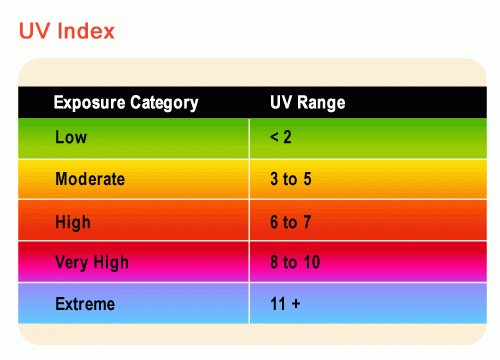UV Index Overview
![]()
 The ozone layer shields the Earth from harmful ultraviolet (UV) radiation. Ozone depletion, as well as seasonal and weather variations, cause different amounts of UV radiation to reach the Earth at any given time. The UV Index predicts the ultraviolet radiation levels on a 1-11+ scale, helping people determine appropriate sun-protective behaviors. Several fact sheets explain the UV Index and steps you can take to minimize the risks from overexposure to the sun's rays. The Web site will also display a UV Alert when the level of solar UV radiation is predicted to be unusually high, and consequently the risk of overexposure is greater.
The ozone layer shields the Earth from harmful ultraviolet (UV) radiation. Ozone depletion, as well as seasonal and weather variations, cause different amounts of UV radiation to reach the Earth at any given time. The UV Index predicts the ultraviolet radiation levels on a 1-11+ scale, helping people determine appropriate sun-protective behaviors. Several fact sheets explain the UV Index and steps you can take to minimize the risks from overexposure to the sun's rays. The Web site will also display a UV Alert when the level of solar UV radiation is predicted to be unusually high, and consequently the risk of overexposure is greater.
Some exposure to sunlight can be enjoyable; however, too much could be dangerous. Overexposure to the sun's UV radiation can cause immediate effects such as sunburn and long-term problems such as skin cancer and cataracts. The UV Index provides important information to help you plan your outdoor activities to prevent overexposure to the sun's rays.
The UV Index provides a daily forecast of the expected risk of overexposure to the sun. The Index predicts UV intensity levels on a scale of 1 to 11+, where 1 indicates a minimal risk of overexposure and 11+ means a very high risk. Calculated on a next-day basis for dozens of cities across the United States, the UV Index takes into account clouds and other local conditions that affect the amount of UV radiation reaching the ground in different parts of the country.

For more information about the risk levels, please click here.
By taking a few simple precautions, you can greatly reduce your risk of sun-related illnesses. Consider the following steps:
- Limit your time in the sun between 10:00 a.m. and 4:00 p.m.
- Whenever possible, seek shade.
- Use a broad spectrum sunscreen with an Sun Protection Factor (SPF) of at least 30.
- Wear a wide-brimmed hat and if possible, tightly woven, full-length clothing.
- Wear UV-protective sunglasses.
- Avoid sunlamps and tanning salons.
- Watch for the UV Index daily.
While you should always take precautions against overexposure to the sun, please take special care to adopt the safeguards when the UV Index predicts levels of moderate or above. Watch for UV Index reports in your local newspapers and on television. For more information, see EPA's UV Index pages or National Weather Service's UV Index pages. Exit
